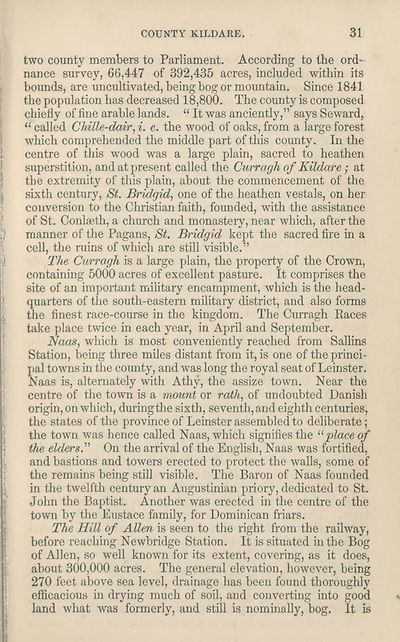Download files
Complete book:
Individual page:
Thumbnail gallery: Grid view | List view

COUNTY KILDARE.
31
two county members to Parliament. According to the ord¬
nance survey, 66,447 of 392,435 acres, included within its
bounds, are uncultivated, being bog or mountain. Since 1841
the population has decreased 18,800. The county is composed
chiefly of fine arable lands. “ It was anciently,” says Seward,
“ called Chille-dair, i. e. the wood of oaks, from a large forest
which comprehended the middle part of this county. In the
centre of this wood was a large plain, sacred to heathen
superstition, and at present called the Curragh of Kildare; at
the extremity of this plain, about the commencement of the
sixth century, St. Bridgid, one of the heathen vestals, on her
conversion to the Christian faith, founded, with the assistance
of St. Conlaeth, a church and monastery, near which, after the
manner of the Pagans, St. Bridgid kept the sacred fire in a
cell, the ruins of which are still visible.”
The Curragh is a large plain, the property of the Crown,
containing 5000 acres of excellent pasture. It comprises the
site of an important military encampment, which is the head¬
quarters of the south-eastern military district, and also forms
the finest race-course in the kingdom. The Curragh Paces
take place twice in each year, in April and September.
Naas, which is most conveniently reached from Sallins
Station, being three miles distant from it, is one of the princi¬
pal towns in the county, and was long the royal seat of Leinster.
Naas is, alternately with Athy, the assize town. Near the
centre of the town is a mount or rath, of undoubted Danish
origin, on which, duringthe sixth, seventh, and eighth centuries,
the states of the province of Leinster assembled to deliberate;
the town was hence called Naas, which signifies the uplace of
the elders." On the arrival of the English, Naas was fortified,
and bastions and towers erected to protect the walls, some of
the remains being still visible. The Baron of Naas founded
in the twelfth century an Augustinian priory, dedicated to St.
John the Baptist. Another was erected in the centre of the
town by the Eustace family, for Dominican friars.
The Hill of Allen is seen to the right from the railway,
before reaching Newbridge Station. It is situated in the Bog
of Allen, so well known for its extent, covering, as it does,
about 300,000 acres. The general elevation, however, being
270 feet above sea level, drainage has been found thoroughly
efficacious in drying much of soil, and converting into good
land what was formerly, and still is nominally, bog. It is
31
two county members to Parliament. According to the ord¬
nance survey, 66,447 of 392,435 acres, included within its
bounds, are uncultivated, being bog or mountain. Since 1841
the population has decreased 18,800. The county is composed
chiefly of fine arable lands. “ It was anciently,” says Seward,
“ called Chille-dair, i. e. the wood of oaks, from a large forest
which comprehended the middle part of this county. In the
centre of this wood was a large plain, sacred to heathen
superstition, and at present called the Curragh of Kildare; at
the extremity of this plain, about the commencement of the
sixth century, St. Bridgid, one of the heathen vestals, on her
conversion to the Christian faith, founded, with the assistance
of St. Conlaeth, a church and monastery, near which, after the
manner of the Pagans, St. Bridgid kept the sacred fire in a
cell, the ruins of which are still visible.”
The Curragh is a large plain, the property of the Crown,
containing 5000 acres of excellent pasture. It comprises the
site of an important military encampment, which is the head¬
quarters of the south-eastern military district, and also forms
the finest race-course in the kingdom. The Curragh Paces
take place twice in each year, in April and September.
Naas, which is most conveniently reached from Sallins
Station, being three miles distant from it, is one of the princi¬
pal towns in the county, and was long the royal seat of Leinster.
Naas is, alternately with Athy, the assize town. Near the
centre of the town is a mount or rath, of undoubted Danish
origin, on which, duringthe sixth, seventh, and eighth centuries,
the states of the province of Leinster assembled to deliberate;
the town was hence called Naas, which signifies the uplace of
the elders." On the arrival of the English, Naas was fortified,
and bastions and towers erected to protect the walls, some of
the remains being still visible. The Baron of Naas founded
in the twelfth century an Augustinian priory, dedicated to St.
John the Baptist. Another was erected in the centre of the
town by the Eustace family, for Dominican friars.
The Hill of Allen is seen to the right from the railway,
before reaching Newbridge Station. It is situated in the Bog
of Allen, so well known for its extent, covering, as it does,
about 300,000 acres. The general elevation, however, being
270 feet above sea level, drainage has been found thoroughly
efficacious in drying much of soil, and converting into good
land what was formerly, and still is nominally, bog. It is
Set display mode to:
![]() Universal Viewer |
Universal Viewer | ![]() Mirador |
Large image | Transcription
Mirador |
Large image | Transcription
| Antiquarian books of Scotland > Ireland/Irish > Black's guide to Killarney and the south of Ireland > (39) |
|---|
| Permanent URL | https://digital.nls.uk/118861136 |
|---|
| Description | Thousands of printed books from the Antiquarian Books of Scotland collection which dates from 1641 to the 1980s. The collection consists of 14,800 books which were published in Scotland or have a Scottish connection, e.g. through the author, printer or owner. Subjects covered include sport, education, diseases, adventure, occupations, Jacobites, politics and religion. Among the 29 languages represented are English, Gaelic, Italian, French, Russian and Swedish. |
|---|

